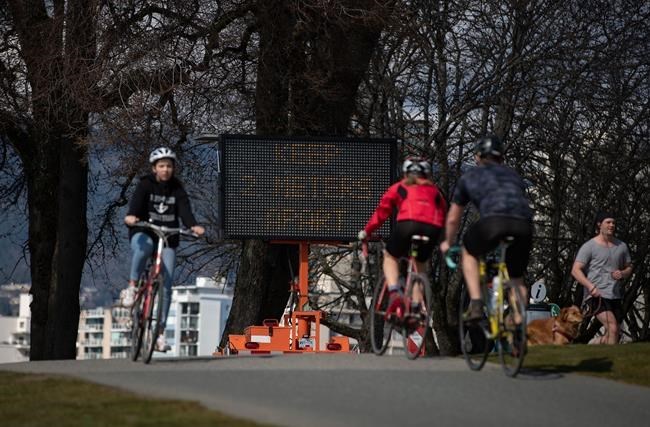VICTORIA — British Columbia's provincial health officer says she's starting to see "glimmers of hope" in an apparent shift toward flattening the curve of COVID-19 cases in the province.
The provincial government released its current and worst-case scenario data on the COVID-19 pandemic Friday. The numbers show the province more closely mirrors the South Korean experience rather than the situation in Italy.
Data suggests travel restrictions and physical distancing are beginning to have an impact. The trajectory of new cases in B.C. changed from a 24 per cent average daily increase to 12 per cent as of March 21.
"I'm trying not to over-call it but I do believe we've seen a flattening, a falling off of that curve," Henry told a news conference.
"I think it is working and I want to tell people what you are doing is making a difference and we need to keep it up for the next coming weeks."
She warned that B.C. is still vulnerable to outbreaks and clusters of cases. The province expects to announce new cases over the coming weeks, she said, so vigilance is crucial.
There have been places where physical distancing was relaxed too soon and cases have risen again, she said.
British Columbia has often led the country in the number of cases reported since the novel coronavirus was first identified in Canada. However, Henry said she believes the models show the province is looking at a lower growth rate of cases because of the early mitigation measures it took.
A model for the rest of Canada shows daily case increases stood at an average of 31 per cent but rose to 39 per cent when Quebec started including probable cases in its reports.
Canadian governments have had the benefit of learning from the experience of other countries and have prepared accordingly, Dix said.
Emergency response began almost two months ago on Jan. 28 in B.C. and health authorities have been working together for two months to develop a strategy to increase their resources to cope with the pandemic.
But the government's modelling indicates there are situations where the health-care system could be overwhelmed.
In the worst-case scenario of a situation similar to northern Italy, hospitals would be short by about 1,778 acute-care beds at the peak of demand. But Dix said additional beds could be added outside hospitals to fill the gap.
The decision to defer scheduled surgeries put B.C. in position to respond to an epidemic level like the one in the Chinese province of Hubei, the government said, although that could vary in different regions of the province.
The province is working with paramedics to transfer patients if necessary.
B.C. appears to have enough ventilators in most scenarios that were modelled, based on an assumption that the machines will be required for 80 per cent of those in intensive care. Once again, there are regional variations on the availability of ventilators in the different scenarios that were modelled.
There are an estimated 348 critical care ventilators available and an additional 120 have been ordered since March 5. Those figures do not include spaces capable of providing ventilator care, such as neonatal units, or the transport of patients. When all available ventilators are included, B.C. counts more than 1,200.
Dix said plans based on severe case models put British Columbia in the best position to respond.
"We are preparing for that scenario regardless of whether it's the most likely scenario or not," he said.
"What we're doing here and what we're presenting here is not what we expect to happen. There will be a B.C. epidemic here, a B.C. COVID-19 situation that will develop. But what we wanted to do was prepare should that situation be as bad as places such as Hubei and Italy. And we have been preparing for months."
— By Amy Smart in Vancouver.
This report by The Canadian Press was first published March 27, 2020.
The Canadian Press



